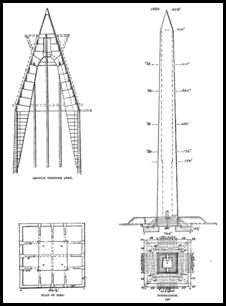The Washington Monument,
Washington D.C.
The Washington Monument
is an obelisk near the west end of the National Mall built to commemorate the
first US president, General George Washington. The monument is both the world's
tallest stone structure and the world's tallest obelisk, standing five hundred
and fifty five feet, five and one eighth inches. There are taller monumental
columns, but they are neither all stone nor true obelisks. It is also the
tallest structure in Washington D. C. It was designed by Robert Mills, an
architect of the 1840’’s. The actual construction of the monument began in 1848 but was not
completed until 1884, almost thirty years after the architect's death. This
hiatus in construction happened because of co-option by the Know Nothing Party,
a lack of funds, and the intervention of the American Civil War. A difference in
shading of the marble, visible approximately one hundred and fifty feet or 27%
up, shows where construction was halted for a number of years. The cornerstone was laid on the 4th of July 1848; the capstone was set
on the 6th of December 1884 and the completed monument was dedicated on the 21st
of February 1885. It officially opened the 9th of October 1888. Upon completion, it became the world's tallest structure, a title
previously held by the Cologne Cathedral. The monument held this designation
until 1889, when the Eiffel Tower was completed.
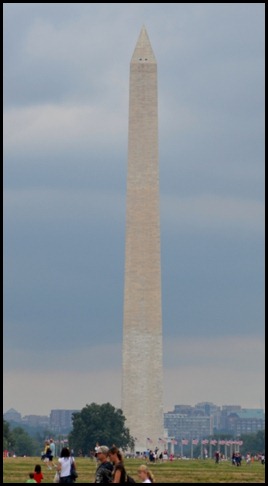
Why Washington: Hailed as the father of his country, and the leader who was "first in
war, first in peace, and first in the hearts of his countrymen", George
Washington (1732-–1799) was the dominant military and political leader of the
new United States of America from 1775 to 1797, leading the American victory
over Britain in the American Revolutionary War as commander in chief of the
Continental Army, and presiding over the writing of the Constitution in 1787. As
the unanimous choice to serve as the first President of the USA, he built a
strong and financially secure nation that earned the respect of the
world.
Sketch of the proposed Washington Monument by architect Robert
Mills circa 1836. New
top design 1885
Design: Progress towards a memorial finally began
in 1832. That year, which marked the 100th anniversary of Washington's birth, a
large group of concerned citizens formed the Washington National Monument
Society. In 1836, after they had raised $28,000 in donations ($600,000 in 2010
dollars), they announced a
competition for the design of the memorial.
On the 23rd of
September 1835, the board of managers of the society described their
expectations:
It is proposed that the
contemplated monument shall be like him in whose honor it is to be constructed,
unparalleled in the world, and commensurate with the gratitude, liberality, and
patriotism of the people by whom it is to be erected ... [It] should blend
stupendousness with elegance, and be of such magnitude and beauty as to be an
object of pride to the American people, and of admiration to all who see it. Its
material is intended to be wholly American, and to be of marble and granite
brought from each state, that each state may participate in the glory of
contributing material as well as in funds to its
construction.
The society held a
competition for designs in 1836. The winner, architect Robert Mills, was
well-qualified for the commission. The citizens of Baltimore had chosen him to build a monument to Washington, and he had
designed a tall Greek column surmounted by a statue of the President. Mills also
knew the capital well, having just been chosen Architect of Public Buildings for
Washington.
His design called for a
tall obelisk - an
upright, four-sided pillar that tapers as it rises - with a nearly flat top. He
surrounded the obelisk with a circular colonnade, the top of which would feature Washington standing in
a chariot. Inside the colonnade would be statues of thirty prominent
Revolutionary War heroes.
One part of Mills'
elaborate design that was built was the doorway surmounted by an Egyptian-style
Winged Sun. It was removed when construction resumed after 1884. A
photo can be seen in The Egyptian Revival by Richard G.
Carrot.
Yet criticism of Mills'
design and its estimated price tag of more than $1 million ($21,200,000 in 2010
dollars) caused the society to hesitate. Its
members decided to start building the obelisk and to leave the question of the
colonnade for later. They believed that if they used the $87,000 they had
already collected to start work; the appearance of the monument would spur
further donations that would allow them to complete the
project.
Dedication: The Monument was formally dedicated on the 22nd of February
(Washington's birthday), 1885. Over eight hundred people attended to hear
speeches by Ohio Senator John Sherman, William Wilson Corcoran (of the Washington National Monument
Society), Thomas Lincoln Casey
of the Army Corps of Engineers
and US President Chester Arthur.
After the speeches General William Tecumseh Sherman
led a procession, which included the dignitaries and the crowd, to the east main
entrance of the Capitol Building,
where President Arthur received passing troops. Then, in the House Chamber, the
president, his Cabinet, diplomats and others listened to Representative John
Davis Long
read a speech given thirty seven years earlier at the laying of the cornerstone.
A final speech was given by Virginia governor John W. Daniel.
Diagram of the Principal High Buildings of the Old
World, 1884. The Washington Monument is the tallest structure
represented.
Tallest building in Washington, D.C.: the Heights of Buildings Act of 1910 restricts new building heights to
no more than twenty feet greater than the width of the adjacent street. This
monument is vastly taller than the obelisks around the capitals of Europe and in
Egypt, but ordinary antique obelisks were quarried as a monolithic block of
stone, and were therefore seldom taller than around the one hundred feet mark.
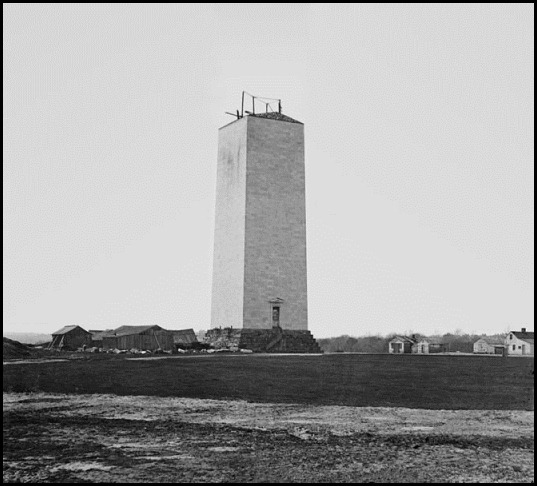
The Monument in 1860
Construction materials and details: Phase One 1848-1858 to the 152-foot level, under the direction of
Superintendent William Daugherty. White marble from Texas, Maryland, also four
courses from Sheffield, Massachusetts.
Phase Two 1878 to 1888. Work completed by the U.S. Army Corps of
Engineers, commanded by Lt. Col. Thomas L. Casey. White marble from a different
Cockeysville quarry. Structural - bluestone gneiss. Commemorative stones are
granite, marble, limestone, sandstone, soapstone and jade. Pyramidal point was
cast by William Frishmuth from aluminium, at the time a rare metal as valuable
as silver. Before the installation it was put on public display and stepped over
by visitors who could later say they had "stepped over the top of the Washington
Monument".
Structure:
Total height of monument: 555 feet 5 1/8th
inches
Height from lobby to observation level: 500 feet
Width at base of monument: 55 feet 1 1/2 inches
Width at top of shaft: 34 feet 5 inches
Thickness of monument walls at base: 15 feet
Thickness of monument walls at observation level: 18 inches
Total weight of monument: 90,854 short tons
Total number of blocks in monument: 36,491
Sway of monument in 30-mile-per-hour wind: 0.125 inches
The cost of the monument was $1,187,710.
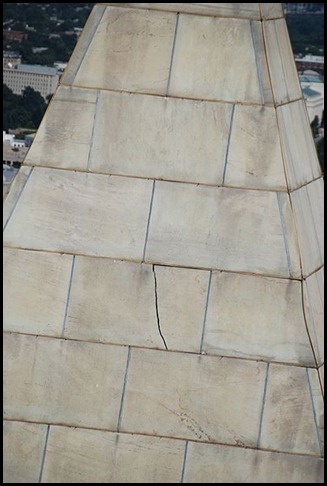
Footnote: On the
23rd of August 2011, the Washington Monument sustained damage during the
Virginia Earthquake. A National Park Service spokesperson reported that
inspectors discovered a crack near the top of the structure, and announced that
the monument would be closed indefinitely. More than $200,000 was spent between the 24th of August
and the 26th of September inspecting the structure. The National Park Service
said that it would soon begin sealing the exterior cracks on the monument in
order to protect it from rain and snow.The external inspection of the monument
was completed on the 5th of October 2011. Besides the four-foot long west crack, the inspection found several
corner cracks and surface spalls (pieces of stone broken loose) at or near the
top of the monument, and more loss of joint mortar lower down the monument. The
full report is due November 2011. Bob Vogel, Superintendent of the National Mall
and Memorial Parks, emphasised that the monument was not in danger of collapse.
"It's structurally sound and not going anywhere", he told the national media at
a press conference on the 26th of September 2011. But Park Service officials
said they had no timetable for when they might reopen the
monument.
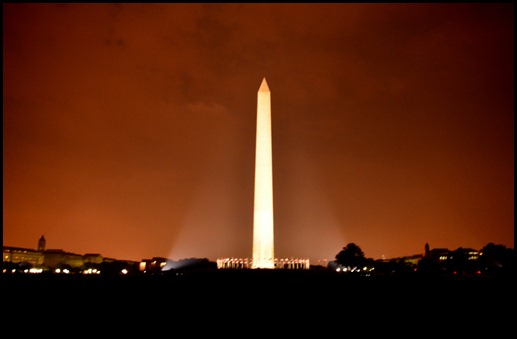
ALL IN ALL IMPRESSIVE AS OBELISKS
GO
INTERESTING HISTORY AND VERY
TALL

